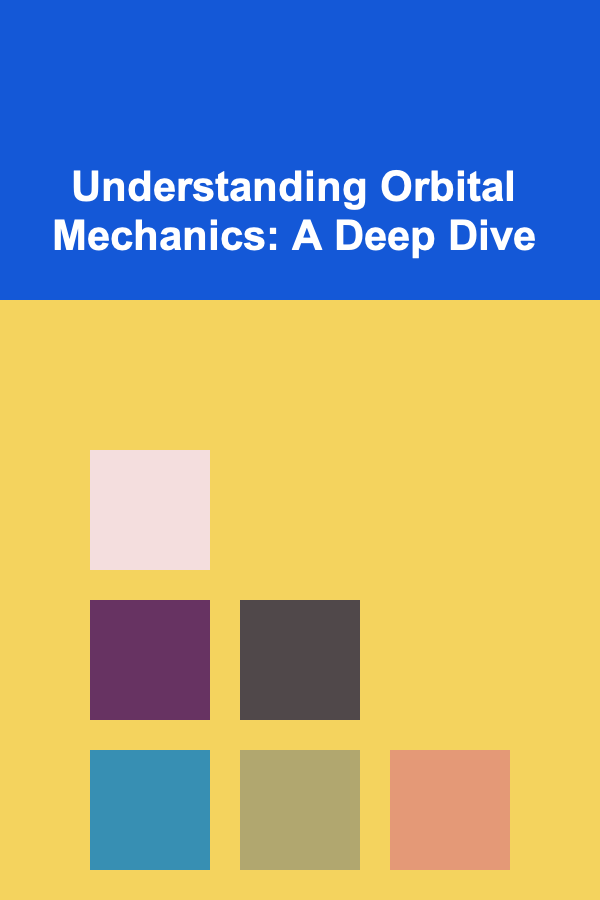
Understanding Orbital Mechanics: A Deep Dive
ebook include PDF & Audio bundle (Micro Guide)
$12.99$5.99
Limited Time Offer! Order within the next:

Orbital mechanics, also known as astrodynamics, is the study of the motion of artificial satellites and natural celestial bodies under the influence of gravity. It's a complex field involving physics, mathematics, and engineering, but understanding the fundamental principles can provide a fascinating insight into how our solar system and beyond function. This article delves into the core concepts of orbital mechanics, providing a comprehensive overview suitable for both beginners and those seeking a deeper understanding.
Newton's Laws and Gravity: The Foundation
At the heart of orbital mechanics lie Newton's laws of motion and his law of universal gravitation. These laws provide the fundamental framework for understanding how objects move in space.
Newton's Laws of Motion:
- First Law (Inertia): An object at rest stays at rest, and an object in motion stays in motion with the same speed and in the same direction unless acted upon by a force. This explains why satellites don't simply stop moving; they continue in their orbit due to inertia.
- Second Law (F=ma): The force acting on an object is equal to the mass of the object times its acceleration. This is perhaps the most crucial law, as it directly relates force to changes in motion. The gravitational force experienced by a satellite directly influences its acceleration, and hence its orbital path.
- Third Law (Action-Reaction): For every action, there is an equal and opposite reaction. This law is less directly applicable to simple orbital calculations but plays a role in understanding the interactions between orbiting bodies, especially in multi-body systems.
Newton's Law of Universal Gravitation:
This law states that every particle attracts every other particle in the universe with a force that is proportional to the product of their masses and inversely proportional to the square of the distance between their centers. Mathematically, it's expressed as:
F = G * (m1 * m2) / r^2^
Where:
- F is the force of gravity
- G is the gravitational constant (approximately 6.674 × 10^-11^ Nm^2^/kg^2^)
- m1 and m2 are the masses of the two objects
- r is the distance between the centers of the two objects
This law is the driving force behind orbital motion. The larger the masses and the smaller the distance, the stronger the gravitational force, and therefore the greater the acceleration of the orbiting body.
Kepler's Laws of Planetary Motion: Empirical Observations
Johannes Kepler, using meticulous observations, formulated three laws of planetary motion long before Newton provided the theoretical framework. These laws are empirical, meaning they are based on observation rather than derived from fundamental principles. They are, however, remarkably accurate and fundamental to understanding orbital shapes and periods.
Kepler's First Law (Law of Ellipses):
The orbit of a planet is an ellipse with the Sun at one of the two foci. This means that orbits are not perfect circles, but rather flattened circles with varying distances between the orbiting body and the central body.
Image illustrating Kepler's First Law (Source: Wikimedia Commons)
Key terms related to elliptical orbits:
- Focus (plural: Foci): One of two points inside the ellipse which defines its shape. The central body (e.g., the Sun, Earth) is located at one focus.
- Semi-major Axis (a): Half of the longest diameter of the ellipse. It represents the average distance between the orbiting body and the central body. It's also the key determinant of the orbital period (as we'll see in Kepler's Third Law).
- Semi-minor Axis (b): Half of the shortest diameter of the ellipse.
- Periapsis: The point in the orbit closest to the central body (e.g., perihelion for orbits around the Sun, perigee for orbits around the Earth).
- Apoapsis: The point in the orbit farthest from the central body (e.g., aphelion for orbits around the Sun, apogee for orbits around the Earth).
- Eccentricity (e): A measure of how much an ellipse deviates from a perfect circle. It ranges from 0 (a perfect circle) to almost 1 (a very elongated ellipse). It's calculated as e = sqrt(1 - (b^2^/a^2^)).
Kepler's Second Law (Law of Equal Areas):
A line segment joining a planet and the Sun sweeps out equal areas during equal intervals of time. This means that a planet moves faster when it is closer to the Sun (near perihelion) and slower when it is farther away (near aphelion). The area swept out per unit time is constant, and this constant is related to the orbital angular momentum.
Animation illustrating Kepler's Second Law (Source: Wikimedia Commons)
This law is a direct consequence of the conservation of angular momentum. As the distance to the central body decreases, the velocity must increase to maintain a constant angular momentum.
Kepler's Third Law (Law of Harmonies):
The square of the orbital period of a planet is directly proportional to the cube of the semi-major axis of its orbit. Mathematically:
T^2^ ∝ a^3^
Where:
- T is the orbital period (the time it takes to complete one orbit)
- a is the semi-major axis
A more precise form of Kepler's Third Law, incorporating the masses of both the central body (M) and the orbiting body (m) and the gravitational constant (G), is:
T^2^ = (4π^2^ / G(M + m)) * a^3^
Often, for satellite orbits around planets, the mass of the satellite (m) is negligible compared to the mass of the planet (M), so the equation simplifies back to the proportional relationship. This law is extremely useful for calculating the orbital period of a satellite given its semi-major axis, or vice versa.
Example: Calculate the orbital period of a satellite orbiting Earth at a semi-major axis of 7000 km (7,000,000 meters). Assume the mass of the Earth is 5.972 × 10^24^ kg and G = 6.674 × 10^-11^ Nm^2^/kg^2^.
T^2^ = (4π^2^ / G(M + m)) * a^3^
Assuming m is negligible compared to M:
T^2^ ≈ (4π^2^ / (6.674 × 10^-11^ * 5.972 × 10^24^)) * (7,000,000)^3^
T^2^ ≈ 2.087 × 10^7^ s^2^
T ≈ √(2.087 × 10^7^) s
T ≈ 4568 seconds ≈ 76.1 minutes
Therefore, the orbital period is approximately 76.1 minutes.
Orbital Elements: Describing Orbits
To fully describe an orbit in three-dimensional space, we need six parameters, known as the orbital elements (also called Keplerian elements). These elements provide a complete and unambiguous description of the orbit's size, shape, and orientation in space.
- Semi-major Axis (a): As described earlier, it defines the size of the orbit.
- Eccentricity (e): As described earlier, it defines the shape of the orbit.
- Inclination (i): The angle between the orbital plane and a reference plane (typically the ecliptic plane for solar system orbits or the Earth's equatorial plane for geocentric orbits). It ranges from 0° to 180°. 0° means the orbit is directly over the equator, 90° means the orbit is polar (passes over the poles), and 180° means the orbit is retrograde (opposite direction of the central body's rotation).
- Longitude of the Ascending Node (Ω): The angle from a reference direction (typically the vernal equinox) to the ascending node, measured in the reference plane. The ascending node is the point where the orbit crosses the reference plane going from south to north. This element defines the orientation of the orbit within the reference plane.
- Argument of Periapsis (ω): The angle from the ascending node to the periapsis, measured in the orbital plane. This element defines the orientation of the ellipse within the orbital plane.
- True Anomaly (ν): The angle between the periapsis and the current position of the orbiting body, measured in the orbital plane. This element defines the position of the orbiting body at a specific time. Other anomalies, such as eccentric anomaly and mean anomaly, are often used in calculations because they are related to time in a more straightforward way.
Image illustrating the Orbital Elements (Source: Wikimedia Commons)
These six elements uniquely define an orbit. Given these elements, it is possible to calculate the position and velocity of the orbiting body at any point in time, and vice versa.
Orbital Maneuvers: Changing Orbits
Orbital maneuvers involve changing the orbit of a spacecraft, typically by using thrusters to apply a force. These maneuvers require precise calculations and careful execution, as even small errors can lead to significant deviations from the desired orbit.
Hohmann Transfer Orbit:
The Hohmann transfer orbit is an elliptical orbit used to transfer between two circular orbits of different radii around a central body. It's the most fuel-efficient two-impulse transfer between two coplanar circular orbits. "Coplanar" means the orbits are in the same plane.
Image illustrating the Hohmann Transfer Orbit (Source: Wikimedia Commons)
The maneuver involves two impulses (burns):
- First Impulse: At the initial circular orbit, a burn is performed to accelerate the spacecraft into the Hohmann transfer orbit. This burn increases the spacecraft's velocity, raising its apoapsis to the radius of the target circular orbit.
- Second Impulse: At the apoapsis of the Hohmann transfer orbit, another burn is performed to circularize the orbit at the target radius. This burn further increases the spacecraft's velocity, making it match the velocity of the target orbit.
The total delta-v (change in velocity) required for a Hohmann transfer is dependent on the ratio of the radii of the two circular orbits. While fuel-efficient, the Hohmann transfer is also time-consuming, as the spacecraft must travel half the circumference of the elliptical transfer orbit.
Bi-elliptic Transfer:
The bi-elliptic transfer is another type of orbital transfer that can be more fuel-efficient than the Hohmann transfer in certain situations, particularly when the ratio of the radii of the two circular orbits is very large. It involves two Hohmann transfers -- the first to a higher (or lower) orbit, then the second to the target orbit. This requires three impulses.
Image illustrating the Bi-elliptic Transfer Orbit (Source: Wikimedia Commons)
Orbital Plane Changes:
Changing the inclination of an orbit requires a significant amount of delta-v, especially at high velocities. The most efficient point to perform an inclination change is at either the ascending or descending node. The required delta-v is approximately:
Δv ≈ 2 * v * sin(Δi/2)
Where:
- Δv is the change in velocity required
- v is the orbital velocity
- Δi is the change in inclination (in radians)
This equation highlights that the higher the orbital velocity, the more delta-v is required to change the inclination. Therefore, inclination changes are often performed at apoapsis where the velocity is lowest.
Perturbations: Deviations from Ideal Orbits
The models described above are based on the idealized two-body problem (only considering the gravitational interaction between two point masses). In reality, orbits are subject to various perturbations that cause them to deviate from these ideal Keplerian orbits. These perturbations arise from a variety of sources:
- Non-Spherical Earth (or Central Body): The Earth, and most celestial bodies, are not perfect spheres. The oblateness (flattening at the poles and bulging at the equator) creates a non-uniform gravitational field, which perturbs the orbit. This is particularly noticeable for low-Earth orbits. The J2 perturbation, caused by the Earth's oblateness, is the largest perturbation effect for many satellites.
- Third-Body Gravitational Effects: The gravitational influence of other celestial bodies (e.g., the Sun, Moon, other planets) can perturb the orbit. These effects are more significant for orbits that are far from the central body. Lagrange points are a result of this three-body interaction.
- Atmospheric Drag: For low-Earth orbits, atmospheric drag can significantly slow down the spacecraft, causing it to lose altitude and eventually re-enter the atmosphere. The density of the atmosphere varies with altitude, solar activity, and time of day, making it difficult to model precisely.
- Solar Radiation Pressure: Photons from the Sun exert a small amount of pressure on the spacecraft, which can gradually alter its orbit, especially for spacecraft with large surface areas and low masses (e.g., satellites with large solar panels).
- Relativistic Effects: For very high-precision calculations or for orbits around very massive objects, relativistic effects (predicted by Einstein's theory of general relativity) need to be considered. These effects are typically small but can become significant over long periods of time.
Accurately modeling these perturbations is crucial for long-term orbit prediction and mission planning. Sophisticated software tools are used to account for these effects and ensure that spacecraft remain on their intended trajectories.
Example: Geosynchronous Orbit and Station Keeping: Satellites in geosynchronous orbit appear to stay in the same position in the sky as viewed from Earth. While the ideal geosynchronous orbit is circular, equatorial, and at a specific altitude, perturbations, particularly due to the Earth's oblateness and the gravitational pull of the Sun and Moon, cause the satellite to drift. Therefore, these satellites require periodic station-keeping maneuvers (small thruster firings) to maintain their desired position. Without these maneuvers, they would slowly drift out of their assigned orbital slot.
Orbital Stability and Chaos
While we often think of orbits as stable and predictable, the reality is that many orbits are, in fact, chaotic. The long-term behavior of these orbits is highly sensitive to initial conditions, making them difficult to predict with certainty over extended periods. This is particularly true in multi-body systems where the gravitational interactions are more complex.
Lagrange Points:
Lagrange points are five points in a two-body system (e.g., Earth-Sun, Earth-Moon) where a small object can maintain a stable position relative to the two larger bodies. At these points, the gravitational forces of the two larger bodies and the centrifugal force balance each other. Lagrange points are designated L1, L2, L3, L4, and L5.
Image illustrating Lagrange Points (Source: Wikimedia Commons)
L1, L2, and L3 are unstable equilibrium points, meaning that a small displacement from these points will cause the object to drift away. L4 and L5 are stable equilibrium points, provided the mass ratio of the two larger bodies is sufficiently large (greater than approximately 24.96). Many asteroids (Trojan asteroids) are found orbiting near the L4 and L5 points of Jupiter. Spacecraft are often placed in orbits around the L1 and L2 points for scientific observations, such as the James Webb Space Telescope at the Sun-Earth L2 point.
Chaotic Orbits in the Solar System:
The orbits of some asteroids and comets can be highly chaotic, making their long-term trajectories difficult to predict. Small gravitational perturbations from planets can cause these objects to change their orbits dramatically, potentially leading to collisions with planets or ejection from the solar system.
Understanding orbital stability and chaos is crucial for predicting the long-term behavior of celestial bodies and for designing stable orbits for spacecraft.
Practical Applications of Orbital Mechanics
Orbital mechanics is not just a theoretical field; it has numerous practical applications in various areas:
- Satellite Communication: Designing and maintaining orbits for communication satellites to ensure continuous coverage of specific regions on Earth. Geostationary orbits are commonly used for this purpose.
- Earth Observation: Placing satellites in specific orbits (e.g., Sun-synchronous orbits) to monitor the Earth's environment, weather patterns, and land use.
- Navigation: Using constellations of satellites (e.g., GPS, Galileo, GLONASS) to provide accurate positioning and timing information for navigation on Earth.
- Space Exploration: Planning trajectories for spacecraft to travel to other planets, moons, and asteroids. This involves complex orbital maneuvers and gravity assists (using the gravitational pull of planets to change the spacecraft's velocity and trajectory).
- Space Debris Mitigation: Tracking and predicting the orbits of space debris to avoid collisions with operational satellites. Developing strategies for de-orbiting space debris to prevent it from becoming a long-term hazard.
- Military Applications: Utilizing satellites for reconnaissance, surveillance, and communication in support of military operations.
- Scientific Research: Placing telescopes and other scientific instruments in space to study the universe without the interference of the Earth's atmosphere.
These applications demonstrate the importance of orbital mechanics in modern society. As space exploration and utilization continue to expand, the demand for skilled professionals in this field will continue to grow.
Conclusion
Understanding orbital mechanics is essential for anyone interested in space exploration, satellite technology, or the dynamics of our solar system. By grasping the fundamental principles of Newton's laws, Kepler's laws, orbital elements, orbital maneuvers, and perturbations, one can gain a deeper appreciation for the complexities and wonders of celestial motion. While this article provides a comprehensive overview, further study and exploration are encouraged to delve even deeper into this fascinating field. The continuous advancements in space technology and the increasing interest in space exploration guarantee that orbital mechanics will remain a vital and exciting area of study for years to come.

How to Create Custom Shelving Solutions for Your Unique Space
Read More
How to Market Your Health and Nutrition Services to Individuals and Businesses
Read More
How to Set Up a Weekly Cleaning Routine
Read More
How to Store Electronics and Cables Without Cluttering Your Home
Read More
How To Create Engaging Virtual Team Building Activities
Read More
How To Create a Standout Remote Work Resume
Read MoreOther Products

How to Create Custom Shelving Solutions for Your Unique Space
Read More
How to Market Your Health and Nutrition Services to Individuals and Businesses
Read More
How to Set Up a Weekly Cleaning Routine
Read More
How to Store Electronics and Cables Without Cluttering Your Home
Read More
How To Create Engaging Virtual Team Building Activities
Read More